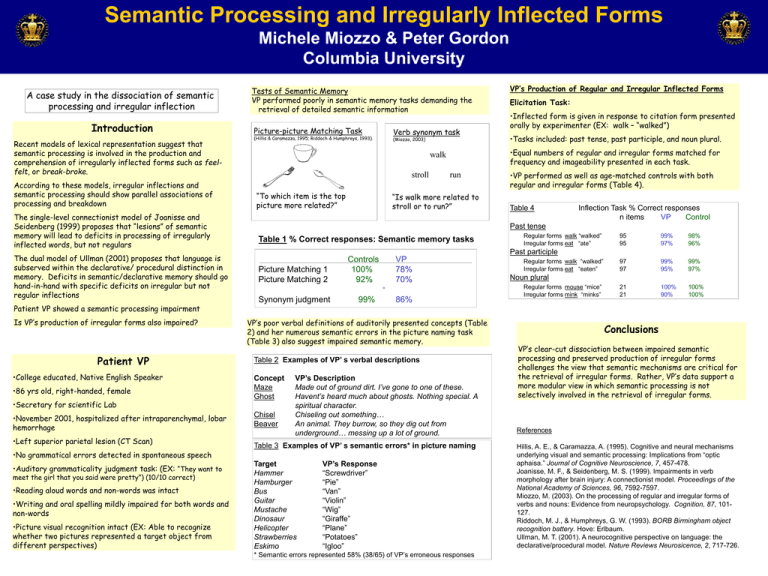Semantic Processing and Irregularly Inflected Forms Michele Miozzo & Peter Gordon
advertisement

Semantic Processing and Irregularly Inflected Forms Michele Miozzo & Peter Gordon Columbia University A case study in the dissociation of semantic processing and irregular inflection Introduction Recent models of lexical representation suggest that semantic processing is involved in the production and comprehension of irregularly inflected forms such as feelfelt, or break-broke. According to these models, irregular inflections and semantic processing should show parallel associations of processing and breakdown The single-level connectionist model of Joanisse and Seidenberg (1999) proposes that “lesions” of semantic memory will lead to deficits in processing of irregularly inflected words, but not regulars The dual model of Ullman (2001) proposes that language is subserved within the declarative/ procedural distinction in memory. Deficits in semantic/declarative memory should go hand-in-hand with specific deficits on irregular but not regular inflections Patient VP showed a semantic processing impairment Is VP’s production of irregular forms also impaired? Patient VP •College educated, Native English Speaker •86 yrs old, right-handed, female •Secretary for scientific Lab •November 2001, hospitalized after intraparenchymal, lobar hemorrhage •Left superior parietal lesion (CT Scan) •No grammatical errors detected in spontaneous speech •Auditory grammaticality judgment task: (EX: “They want to meet the girl that you said were pretty”) (10/10 correct) •Reading aloud words and non-words was intact •Writing and oral spelling mildly impaired for both words and non-words •Picture visual recognition intact (EX: Able to recognize whether two pictures represented a target object from different perspectives) Tests of Semantic Memory VP performed poorly in semantic memory tasks demanding the retrieval of detailed semantic information Picture-picture Matching Task (Hillis & Caramazza, 1995; Riddoch & Humphreys, 1993). Verb synonym task (Miozzo, 2003) “To which item is the top picture more related?” Elicitation Task: •Inflected form is given in response to citation form presented orally by experimenter (EX: walk – “walked”) •Tasks included: past tense, past participle, and noun plural. •Equal numbers of regular and irregular forms matched for frequency and imageability presented in each task. walk stroll VP’s Production of Regular and Irregular Inflected Forms run “Is walk more related to stroll or to run?” •VP performed as well as age-matched controls with both regular and irregular forms (Table 4). Table 4 Inflection Task % Correct responses n items VP Control Past tense Table 1 % Correct responses: Semantic memory tasks Regular forms walk “walked” Irregular forms eat “ate” 95 95 99% 97% 98% 96% 97 97 99% 95% 99% 97% 21 21 100% 90% 100% 100% Past participle Picture Matching 1 Picture Matching 2 Synonym judgment Controls 100% 92% 99% VP 78% 70% 86% VP’s poor verbal definitions of auditorily presented concepts (Table 2) and her numerous semantic errors in the picture naming task (Table 3) also suggest impaired semantic memory. Table 2 Examples of VP’ s verbal descriptions Concept Maze Ghost Chisel Beaver VP’s Description Made out of ground dirt. I’ve gone to one of these. Havent’s heard much about ghosts. Nothing special. A spiritual character. Chiseling out something… An animal. They burrow, so they dig out from underground… messing up a lot of ground. Table 3 Examples of VP’ s semantic errors* in picture naming Target Hammer Hamburger Bus Guitar Mustache Dinosaur Helicopter Strawberries Eskimo VP’s Response “Screwdriver” “Pie” “Van” “Violin” “Wig” “Giraffe” “Plane” “Potatoes” “Igloo” * Semantic errors represented 58% (38/65) of VP’s erroneous responses Regular forms walk “walked” Irregular forms eat “eaten” Noun plural Regular forms mouse “mice” Irregular forms mink “minks” Conclusions VP’s clear-cut dissociation between impaired semantic processing and preserved production of irregular forms challenges the view that semantic mechanisms are critical for the retrieval of irregular forms. Rather, VP’s data support a more modular view in which semantic processing is not selectively involved in the retrieval of irregular forms. References Hillis, A. E., & Caramazza, A. (1995). Cognitive and neural mechanisms underlying visual and semantic processing: Implications from “optic aphaisa.” Journal of Cognitive Neuroscience, 7, 457-478. Joanisse, M. F., & Seidenberg, M. S. (1999). Impairments in verb morphology after brain injury: A connectionist model. Proceedings of the National Academy of Sciences, 96, 7592-7597. Miozzo, M. (2003). On the processing of regular and irregular forms of verbs and nouns: Evidence from neuropsychology. Cognition, 87, 101127. Riddoch, M. J., & Humphreys, G. W. (1993). BORB Birmingham object recognition battery. Hove: Erlbaum. Ullman, M. T. (2001). A neurocognitive perspective on language: the declarative/procedural model. Nature Reviews Neurosicence, 2, 717-726.




